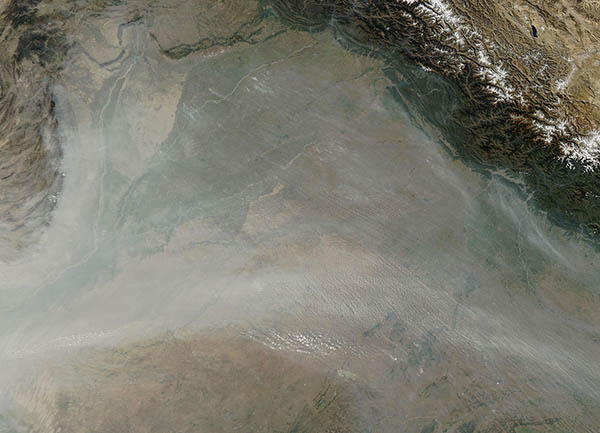Images
November 2, 2024 - Seasonal Haze over Northern India
Tweet
Smoke and haze covered northern India on October 31, 2024, when the Moderate Resolution Imaging Spectroradiometer (MODIS) on NASA’s Aqua satellite acquired a true-color image of the scene.
The primary source of the haze appears to be widespread agricultural fires, as evidenced by the time of year, the location, and the multiple plumes of smoke rising from areas known to practice seasonal burning of crops. Many farmers, particularly in the states of Punjab and Haryana, use fire as a fast, cheap way to clean up and fertilize fields before planting winter crops. However, a surge of smoke in the heart of the densely populated Indo-Gangetic Plain often contributes to a sharp deterioration of air quality across the region, including in the capital city of Delhi.
The widespread haze occurs seasonally, beginning in late October or early November, when crop fires send smoke to mix with other pollutants, such as emissions from cooking and heating fires, urban aerosols rising from traffic and industry, and other sources both natural and human-caused. The haze also becomes more noticable when aerosol (particle) pollutants are pumped into the atmosphere when colder air up high (inversion) traps air pollution close to the ground.
Image Facts
Satellite:
Aqua
Date Acquired: 10/31/2024
Resolutions:
1km (184.7 KB), 500m (477.4 KB), 250m (1.4 MB)
Bands Used: 1,4,3
Image Credit:
MODIS Land Rapid Response Team, NASA GSFC
Tweet
Smoke and haze covered northern India on October 31, 2024, when the Moderate Resolution Imaging Spectroradiometer (MODIS) on NASA’s Aqua satellite acquired a true-color image of the scene.
The primary source of the haze appears to be widespread agricultural fires, as evidenced by the time of year, the location, and the multiple plumes of smoke rising from areas known to practice seasonal burning of crops. Many farmers, particularly in the states of Punjab and Haryana, use fire as a fast, cheap way to clean up and fertilize fields before planting winter crops. However, a surge of smoke in the heart of the densely populated Indo-Gangetic Plain often contributes to a sharp deterioration of air quality across the region, including in the capital city of Delhi.
The widespread haze occurs seasonally, beginning in late October or early November, when crop fires send smoke to mix with other pollutants, such as emissions from cooking and heating fires, urban aerosols rising from traffic and industry, and other sources both natural and human-caused. The haze also becomes more noticable when aerosol (particle) pollutants are pumped into the atmosphere when colder air up high (inversion) traps air pollution close to the ground.
Image Facts
Satellite:
Aqua
Date Acquired: 10/31/2024
Resolutions:
1km (184.7 KB), 500m (477.4 KB), 250m (1.4 MB)
Bands Used: 1,4,3
Image Credit:
MODIS Land Rapid Response Team, NASA GSFC




